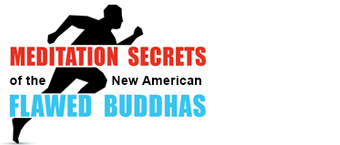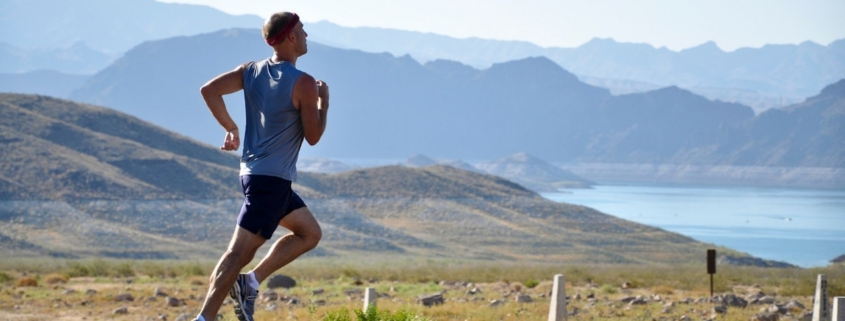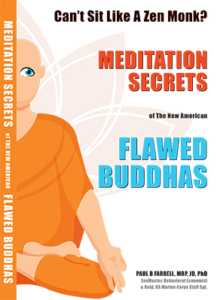Last Updated on March 19, 2021 by Paul Farrell, MRP, JD, PhD

Running! Running! Running!… perfect “action meditation” for 68,000,000… when “in the zone”… you become “the running!”
“There is a part of every marathon where something does take over … the sensation of movement … You lose a sense of identity in yourself, you become running itself … I only have to think of putting on my running shoes and the kinesthetic pleasure of floating along, the pleasure of movement starts to come. I get a feeling of euphoria, almost real happiness … It is the platonic idea of knowing thyself. Running is getting to know yourself to an extreme degree.”
– Ian Thompson, world champion marathoner
Running has long been known as a natural meditation for recreational athletes. Then suddenly, a few decades ago, running moved into the spotlight when it also became known as a “positive addiction,” thanks to the so-called “runners high,” where the runner, the running, and the world move in harmony.
Back in the mid-seventies – about the time the relaxation response and transcendental meditation were emerging as hot topics – noted psychiatrist William Glasser, M.D., author of the bestseller Reality Therapy, was working on a research project to determine if people could become addicted to positive behavior.
Running Is America’s #1 “Positive Addiction!”
His research covered a wide range of activities: singing and playing musical instruments, knitting, yoga, exercise, weightlifting, hiking, swimming, cycling, rock climbing – and running – which Dr. Glasser ultimately concluded is not only America’s most common positive addiction, it is also “the hardest but surest way to positive addiction.”

“The positive addict enjoys his addiction but it does not dominate his life.” – William Glasser, M.D.
Early in his research Dr. Glasser contacted Joe Henderson, editor of Runner’s World magazine, about his idea that running was a positive addiction. Henderson, a self-admitted eighteen-year running addict, loved the idea and featured Glasser’s questionnaire in the magazine.
Glasser’s questionnaire asked for detailed information on things like: how long have you been running, how often, competitions, efforts to improve, do you run solo or in groups, how do you deal with discomfort and injuries, any bad habits released, the positive benefits, your state of mind while running, other positive activities, like yoga, music, sports, meditation.
The New Zen … When “You Become Running Itself”
Then came the pleasant surprise: Glasser did not expect the avalanche of responses, more than seven hundred arrived. And seventy-five percent of them identified themselves as addicted! The results were published in his book, Positive Addictions.
World champion marathoner Ian Thompson best explained why runners become addicted to running. “Runner’s high” is actually too nebulous a description. But Thompson talks specifically of the feeling of euphoria and loss of identity, ego and self as you are floating along in the rhythm of the running movement – “you become running itself!” – and that’s a perfect meditation!
Running Meditation Beats Maharishi’s “Transcendental Meditation”
In the interview with John Roemer, a 36-year-old marathoner who had been running five-six times a week for over five years, Roemer noted that what he got “from running is almost exactly what the Maharishi Mahesh Yogi claims would happen if everyone practiced transcendental meditation.”
A similar comparison was made by William Bat, who has been running for a couple years. He described his state of mind as “a state of sublimation similar to that experienced during transcendental meditation.” But, he added, TM “requires two twenty-minute periods daily and relative privacy, neither of which is easy to find in today’s typical lifestyle.”

Running meditation is a time to lose yourself in nature.
He would rather spend the time running because it is “a period free of mental stress and structured thought, a time to lose myself in nature,“ said Bat, adding that “several times I have begun my run with the intention of thinking out a problem but this doesn’t seem to work for me. I immediately get caught up in the pure and simple act of running.” Pure running – and pure meditation.
You “Go Into The Void” No Thinking, No Chatter —Peace
Glasser’s runners clearly prefer running as their meditation rather than any sitting meditation. In fact, so many of the runners described the experience of running in ways you’d expect to hear from monks in sitting meditation – Jim Cory, a runner for eleven years: “I don’t think at all. My awareness is only of the present. Even that cannot be called awareness. Brain chatter is gone.”
And Ronald Rombaski, a 38-year-old businessman, added that while he is running “my mind is resting in a vacuum … resting … not functioning,” an expression that sounds like ‘the void’ or ultimate unknowable spirit at the core of 2,500-year-old Taoist bible, the Tao Te Ching, a perfect state of mind for the meditation experience.
Beyond Quaker Meditation Into A New “Zen Running”
Another wonderful expression of running meditation came from Martha Clopfer, a 39-year-old part-time teacher and farmer who had been running five times a week for five years. When asked about her state of mind while running she said: “Meditative is probably the best single word but it is different from Quaker meeting type meditation. The most similar state of mind I know comes from listening to music for pleasure.”
And like many other runners, Clopfer spoke of becoming one with the flow: “The rhythm of running is a strong element. Sometimes problems get solved while I am running or I think of things to say to people but it is not a figuring out process. More of a sudden flash of insight that comes when you are least trying to find an answer.” Once again, that kind of sudden flash of insight reminds us of satori, the sudden enlightenment Zen masters experience in zazen meditation.
Ironman Triathlons, Marathons, Tour de France
Today you’ll find the principles of sports psychology, mental training and moving meditations in virtually every recent book on running and related sports, marathons and triathlons, swimming and cycling, as well as the Tour de France—and usually somewhere in each is a comment like “your mental training is as important as your physical training,” plus discussions of other meditation techniques; visualization, focusing, confidence and others.
A few that come to mind are: Runner’s World’s Complete Book of Running, edited by Amby Burfoot, a Boston Marathon winner; Marathon: The Ultimate Training Guide by Hal Higdon; Swim Bike Run by Hobson, Campbell & Vickers; Be Iron Fit by Don Fink a Wall Street investment banker for twenty years before retiring to enter Ironman competitions; and The Ultimate Ride by cycling coach, Chris Carmichael. Add cycling activists to running and the data doubles.
Chi-Running Meditation Focus… Scan… Breathe… Relax
One especially intriguing book for runners is Danny Dreyer’s Chi Running. Danny’s a running coach and nationally ranked ultra-marathon runner with thirty years experience. Chi-running is a way of training to run effortless and injury-free using four mind/body skills that Dreyer integrated into his running from work with Tai Chi masters.
These four meditation skills are now in common use among sports psychologists and Western stress management clinicians in general as well as with runners, thanks to Dreyer and other professionals like him:
- Focusing Your Mind, rather than letting it wander into distractions
- Body Sensing: Scanning and listening to your body’s signals
- Breathing: Tapping into Your Chi. New power through the breath
- Relaxation: The Path of Least Resistance. Moving free and loose
Sound familiar? Of course it does. Here are four very familiar techniques and goals we see mentioned over and over in discussions about virtually every one of the popular sitting meditation programs worldwide today.
Except now these techniques are being accepted as an integral part not just of the practice of Tai Chi but of many other moving meditation disciplines such as running. And here we see a great running coach blending these basic meditation skills into the runner’s world, and in the process transforming running into a truly effective method of moving meditation.
New “Blue Jean Buddhas” and the 1,000 Day Marathon
A new generation of American Buddhists are also finding their meditation in running. In Sumi Loundon’s recent book, Blue Jean Buddha: Voices of Young Buddhists we hear David Suniga tell us not only of his experience—well, listen to what he discovered: “My spiritual path as a runner has revealed itself gradually. … Running naturally lends itself to Buddhist practice; it has been the primary form of meditation form some Japanese and Tibetan orders for over 1,200 years.”
“Only a select few of the Japanese Tendai monks of Mount Hiei are allowed to undergo the sennichi kaihogyo (1,000-day marathon), which spans seven years. For the first three years, the monks complete a yearly ritual of running 24.8 miles every day for 100 consecutive days … The Tendai monks believe they can only accomplish their death-defying physical activities because they are following the bodhisatva path. They achieve complete mastery of the minds and bodies for the sake of all sentient beings. By conquering unimaginable physical pain, they are revered as living buddhas and, like Shakyamuni, prove that dukkha [suffering on earth] can be overcome.”
Running! Running! Running! The Ultimate “Positive Meditation!”
Dr. Glasser was way ahead of his time. In fact, his unique focus on the positive addictive qualities of running and other activities opened the door to the development of sports psychology, while at the same time providing us with a framework for understanding that for many of us running is as powerful and as effective meditation as practicing Transcendental Meditation, or sitting in silence at a Quaker meeting hall, or doing za-zen meditation in a Buddhist temple in Japan.
About the Author
Dr. Farrell is a Behavioral Economist. His books include The Millionaire Code; The Millionaire Meditation: Stress Management for Wall Street, Corporate America & Entrepreneurs; The Zen Millionaire; The Winning Portfolio; Expert Investing on The Net; Mutual Funds on The Net; and The Lazy Person’s Guide to Investing.
He also published 1,643 columns on DowJones-MarketWatch and for years was their #1 traffic-generating columnist. Before the Internet, he edited & published FNX: Future News Index, a financial newsletter for stock market traders. Earlier he was a Wall Street investment banker with Morgan Stanley, Executive Vice President of the Financial News Network; and Associate Editor of the Los Angeles Herald Examiner.
He has a Doctorate in Psychology, Juris Doctor, Masters in Regional Planning and Bachelor of Architecture. He worked on the Esalen organic farm and served in the U.S. Marine Corps as Staff Sergeant in aviation computer technology.








